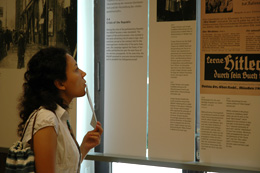
A beautiful Sunday provided the perfect backdrop for a trip to idyllic Wannsee, a place in southwest Berlin well known for its lovely inland beach – one of the longest in Europe. Wannsee is also famous for hosting the conference of the same name on the 20th of January, 1942. Most of us have learned about this event in our contemporary history courses – decisions regarding “the final solution to the Jewish question” were made by fifteen top figures of the SS, NSDAP, and several ministries. Most of us know that a villa in Wannsee was the site of a terrible plan – the deportation and murder of 11 million Jews, but we hadn’t had the chance to see what it feels like to be inside the villa.
Now a memorial and educational house, it allowed both students and professors to catch a glimpse of the historical tensions that culminated in the conference. Fifteen rooms chronologically showcased the evolution of the phenomenon – from racism and anti-semitism to labour and death in concentration camps. Both informative and captivating, the exhibition successfully managed to avoid turning into an overly emotional account. Facts, documents, photographs, biographies, testimonies were sufficient for provoking the desired effect: meditation and inquisitiveness.
The most touching part was the very last: how do people deal with the aftermath of these horrendous times? The son of a labour camp survivor was forever left with a stammer after his father almost choked to death while eating in the same way he did in the camp – anxiously swallowing large pieces of bread. Another man could not talk to his friends about his traumatizing experience – people did not speak about it, even though they went through similar struggles. And others actively engaged in educating the next generations about the dangers of extremism and the importance of learning from the past.
After such an insightful look into a dark section of human history, students split up into smaller groups. Some chose to see Kleist and Vogel’s infamous graves and the Liebermann Villa, others took advantage of the marvelous weather and took a boat trip, while others took refuge in the shadow of tall trees. An impromptu music session, people completely immersed in reading, children happily chasing each other, friends chatting cheerfully over a cold beer, tired visitors dozing off in the comforting breeze – the perfect end to a special day.
Wannsee is a place of contrasts, capable of inducing sadness as well as joy. Much like life itself, it is a setting that fosters remembrance and contemplation, but also hope and happiness. It is the physical expression of forever being stuck in a moment between past and future: reluctant to let go, yet enthusiastic about things to come.
By Catalina Iorga (ISU ’07, Romania)
